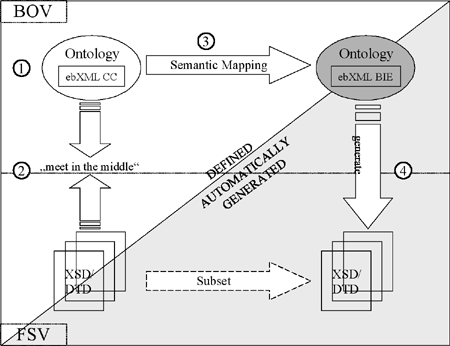 This issue in pdf Archive: |
|
|||
Towards Syntax-Independent B2Bby Birgit Hofreiter, Christian Huemer and Werner Winiwarter When it was introduced, XML seemed to promise a solution to traditional B2B problems. Today, however, we are faced with a multitude of different XML-based e-business vocabularies that are not interoperable. Even in the case of business partners supporting the same e-business vocabulary, interoperability is not guaranteed since they may be implementing different subsets of the same vocabulary's document type. A research team at the University of Vienna addresses these problems with a framework that aims to align concepts known from the Semantic Web and the ebXML initiative. The success of the Internet and XML created a mistaken belief in a global B2B market where businesses would be able to communicate with each other without any prior agreements. These technologies seemed to overcome the most significant obstacles of traditional electronic data interchange (EDI) standards. After the initial excitement however, people realised that while XML provides a means to exchange data between applications, it does not guarantee interoperability. While XML provides a syntax that can be used for data transfer in B2B, it does not provide semantics, since tags have no predefined meaning. The meaning of XML vocabularies is defined by the document designer and is specified outside of XML itself. This resulted in a proliferation of XML-based e-business vocabularies within the first few years of XML's release. Having contributed to the work of UN/CEFACT in the Techniques and Methodology Working Group (TMWG) and ebXML, as well as conducting related research projects such as A-XML and Harmonise, we feel that a true B2B solution needs much more than a purely syntax-based approach. Here we elaborate on the open issues that we see on the road towards syntax-independent B2B. In the future, we expect some vocabularies to disappear and others to merge. Nevertheless, a certain number of well-known 'standard' vocabularies will coexist. This means that business partners must either agree on a certain e-business vocabulary or map between their mutual vocabularies. This is not practicable with a large number of business partners. Consequently, a common syntax-neutral ontology capturing the business semantics independently of vocabulary is desirable. Furthermore, a clearly defined representation of the business semantics in each supported e-business vocabulary is necessary. This approach minimises the effort required since the number of mappings can be kept as low as the number of vocabularies. In this context, two key aspects are highly relevant for the research community, namely, how to build the ontology and the mapping between the ontology and the business vocabularies. A major failure of today's B2B approaches is the issue of overloaded document types. This is the result of the desire to create one single purchase order, one single invoice etc, for the whole world. In order to meet the requirements of any company in any business sector in any geographical region, document types are created by collecting (and structuring) all data elements that might be relevant for any company in any sector in any region. As a consequence, only a very small percentage (usually less than 5%) of data element types are instantiated in a document. To guarantee interoperability, partners have to agree on the relevant subset of the document type prior to the exchange. Thus, documents must be compliant not only with the document types (called valid documents in XML) but also with industry-, region- or partner-specific agreements. Accordingly, we identify a third key aspect for the research community: the automatic adjustment of general document types according to given context parameters such as industry, region, and business process. In order to address these three aspects we suggest drawing on approaches from the Semantic Web and electronic business XML (ebXML). In the Semantic Web community, languages such as RDF and DAML have evolved that can be employed to develop the syntax-neutral ontology. Furthermore, there is ongoing research concerning the transformation of an ontology's semantics into XML representations of certain e-business vocabularies.
EbXML core components are oriented along the most extensive knowledge base in the business world, the trade data element dictionary UN/TDED. Therefore, ebXML core components, which will also be supported by BoleroNet, EAN/UCC, Open-Applications Group (OAG), Open Travel Alliance (OTA) and SWIFT, provide the best semantic foundation for a global business ontology. As ebXML also allows the specification of business processes, their activities and their activity-specific business data, this facilitates the adjustment of business documents to the needs of a business process on the basis of core components, rather than through the use of generic document types. Thus, ebXML provides a good starting point for our third identified aspect. By aligning ontology and ebXML concepts we propose the framework depicted in the Figure. This framework is based on four major steps. In the first step the semantics of ebXML core components are defined in an RDFS-based ontology. The second step defines mappings between the ontology and RDF representations of e-business vocabularies, as well as between the latter RDF representations and the DTDs or XML schemas of the e-business vocabularies. Beyond traditional ontological approaches, we take on the ebXML idea to further restrict a general document ontology to the specific needs of a given business activity. This refinement will lead to a certain view of the general document ontology and must be specified by means of a constraint language. Steps one to three must be done manually and are depicted in the white triangle, whereas the last step depicted in the grey triangle will be derived automatically. Using the information from the previous steps, a more restrictive and appropriated XML schema or DTD for a specific activity will be created. The XSDs and DTDs are a subset of their corresponding general ones. Further restrictions expressed in a declarative language will accompany the document types. This framework focuses on a mapping between different e-business vocabularies and at the same time guarantees their semantic equivalence in support of a specific activity. Links: Please contact: |
|||


